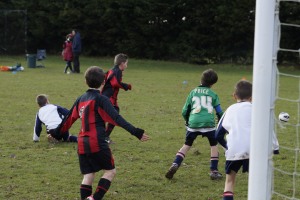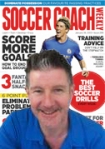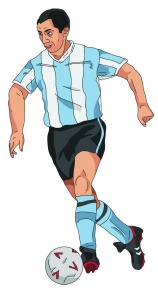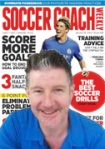Filed under: Dave Clarke, defence, Goalkeeping, Soccer Coaching, Soccer Fitness, Soccer News, Soccer Refereeing, Soccer Skills, Soccer Team Management, Soccer Training | Tags: 1v1, development, key skill, mind games, support play
 When I was first starting out in coaching I remember reading an article about Ron Greenwood, who had played for Chelsea and Fulham and who went on to manage West Ham and the England national team. When asked what the most essential trait was for a soccer player, he said: “Anticipation”.
When I was first starting out in coaching I remember reading an article about Ron Greenwood, who had played for Chelsea and Fulham and who went on to manage West Ham and the England national team. When asked what the most essential trait was for a soccer player, he said: “Anticipation”.
Put simply, it’s the knack of knowing where to be, when to move and sensing what is going to happen before it actually does. It is a trait that all the great players have and it is something I work on with my players, because it’s a trait you can coach.
A good way of creating players who have anticipation is to build the foundations of their technique – and that requires practice. Improving a player’s skill doesn’t just happen and players will not learn skills just by playing games.
Focus practice on basic skills in the early years and then let them advance with more technical skills. One of the Under 10 teams I coach are of a very mixed level of technical ability but the one thing they all have is enthusiasm and dedication for learning new skills. Once we have perfected the first set of skills we move on and develop the basic skills into harder ones.
“Look Dave, I can do what Ronaldo and Messi do!” one of them said to me last week as he spun on the ball and flicked it into the air.
Playing in a match before Christmas the team was losing 2-0 but their heads didn’t drop.
 Early in the second half a wonderful step over took one of my strikers past a defender and his teammate anticipated this, moving quickly for a pass – and before the keeper had even moved, the ball was dispatched into the net.
Early in the second half a wonderful step over took one of my strikers past a defender and his teammate anticipated this, moving quickly for a pass – and before the keeper had even moved, the ball was dispatched into the net.
It was an afternoon of watching great technique and some fabulous passing moves as the opposition were put to the sword. But we didn’t get an equaliser and it was a frustrating moment when the whistle blew.
Back at training I hadn’t expected to see the same players going 1v1 against each other on the muddy practice pitch but all they were bothered about was showing each other how much better their skills were than last week.
I was thrilled to see it. It won’t be long before they turn their potential into winning games and I bet even then they’ll still be going 1v1 against each other just to make themselves that little bit better.
Filed under: Dave Clarke, Soccer Coaching, Soccer Fitness, Soccer News, Soccer Refereeing, Soccer Skills, Soccer Team Management, Soccer Training | Tags: coaching, development, games, organise, rules, sessions, warm ups
 Every so often at training I like to give my players the reins of the session and see how they create a game.
Every so often at training I like to give my players the reins of the session and see how they create a game.
I know my players love to play games, and I love the fun they get out of it. Not only that but they learn much faster and retain more of what they learn from being actively and closely involved in the session.
So I involve my players in setting and changing the rules for the session. The more involved they feel, the more they’ll invest, and undoubtedly, the more they will enjoy it. So maybe try something new out at your next training session. For instance, before your players arrive, mark out a pitch and place a ball in the middle. Make sure there are no other balls available.
As your players arrive, stay away from the playing area and tell them to go out and get started on their own.
When there are enough players they will probably organise themselves into teams and will begin a game. Let them play for five minutes and then stop them. Find out what rules they were playing and why. Then set them a couple of challenges that they have to incorporate into the game, such as asking them to win the ball back within 20 seconds of losing it. Only give them a brief outline of the challenge and see how they work it into the game.
Getting them to think about what they can do to make the game more fun makes them feel part of a unit; it offers them a voice. It’s a great bonding element that goes a long way towards developing a team.
If it doesn’t happen the first time you try it don’t give up. Say to a couple of players as they head outside “Why don’t you get a game started?” You’ll probably notice the younger ones organising full-scale games, while the older kids may be perfecting the finer elements.
Let them play the session for a good 20 or 30 minutes, stopping every five minutes for a quick chat about the rules, seeing if your players want to change anything to make the game more fun.
I’d be willing to bet they don’t want the game to stop because they will see it as their own. And I’m sure that empowerment will mean they go home from training with smiles on their faces.
Filed under: Dave Clarke, Soccer Coaching, Soccer Fitness, Soccer News, Soccer Refereeing, Soccer Skills, Soccer Team Management, Soccer Training | Tags: alf, Ardiles, coerver, development, Football, galustian, japan, maradona, messi, ossie, Soccer, World Cup, youth
 As a young player Ossie Ardiles was smaller than the other boys around him so he wouldn’t pass the ball much – he would just dribble and dribble and dribble. Much like Maradona and Lionel Messi. His brother called him Piton, the snake. In this exclusive interview Soccer Coach Weekly’s David Clarke spoke to him about youth soccer, Argentina legends and Japanese success
As a young player Ossie Ardiles was smaller than the other boys around him so he wouldn’t pass the ball much – he would just dribble and dribble and dribble. Much like Maradona and Lionel Messi. His brother called him Piton, the snake. In this exclusive interview Soccer Coach Weekly’s David Clarke spoke to him about youth soccer, Argentina legends and Japanese success

Most recently Ossie Ardiles was the coach of Machida Zelvia in the second tier of the Japanese J-League, but a 23-year coaching career has taken the Argentinian World Cup winner around the world. As player-manager he introduced a flamboyant style of football to Swindon Town in his first coaching job, achieving promotion to the top flight in 1990 (only for the FA to strip the club of this honour for off-the-field irregularities).
Three years later he took West Brom to Division One and later made headlines in the Premier League with a cavalier Spurs side notable for fielding five forwards. After relocating to Japan he was named J-League Manager Of The Year in 1998 for his work with Shimizu S-Pulse. He won the first stage of the J-League with Yokohama F Marinos in 2000 and the Emperor’s Cup with Tokyo Verdy five years later.
He has also enjoyed spells managing clubs in Mexico, Argentina, Paraguay, Croatia, Israel and Saudi Arabia, giving him a truly global view of the game – but wherever he has coached, he has always brought a certain Ossie style to the job.
DAVID Having coached four clubs in England, is the Premier League the best in the world?
OSSIE“The Premier League is certainly the most watched and the richest – and it attracts the best players in the world because of these reasons. Yes, I would imagine it’s the best league in the world.”
 You have enjoyed several stints in Japan. What is it about the Japanese game that attracts you?
You have enjoyed several stints in Japan. What is it about the Japanese game that attracts you?
“The J-League started in 1993 and I came soon after. I think the J-League is and was the model of how professional football should be marketed for the fans. In Japan I have won the League and The Emperors Cup and I have been told that I also have more victories than any other foreign coach in the league’s history.”
Who have been the coaches that have impressed you the most in Japan?
“There have been some great coaches in Japan: the Brazilian legend Zico, Hans Ooft from Holland, and of course Arsene Wenger. Wenger to me was special – you knew his teams would play football, the beautiful game as Pelé called it. I know his time in Japan influenced him and like me he loved the culture. Since leaving Japan I am not surprised to see he stuck with all his beliefs about the way the game should be played and the way to behave civilly and with respect – the Japanese way.”
Japanese women are world champs and the men are champions of Asia. Why has their game been so successful?
“You need to understand the Japanese culture. Like every aspect of their lives, great attention and care is spent on detail, studying whatever they want to establish and then replicating and improving it. Football was no different. The professional league was marketed to perfection, so the fans supported the game. The Japanese also think long term so youth development was always a priority for the Japanese Football Association. The success of Japanese players and teams today is a result of their youth development programmes.”
As a long-standing champion of youth development and the education of coaches, what programmes have impressed you in Japan?
“In my 17 years here, the programme that has impressed me most, and the one that has dominated nationally, has been the Coerver programme. I remember in the early years they started with a few schools and today they have over 100 schools all over the country. I am a close friend with Alf Galustian, who is a co-founder of the programme and the driving force behind it, so I have always kept a close interest.”
 What is so special about the contribution of Alf Galustian and Coerver to football in Japan?
What is so special about the contribution of Alf Galustian and Coerver to football in Japan?
“Alf is without doubt a global pioneer in youth coaching. I am still amazed with the new drills, games and concepts he continually comes up with. His contribution to Japanese football development is without question. “Over these past 20 years he has influenced the way football is taught in Japan and the subsequent success of the game here. “Currently more than 17,000 young players go through the Coerver programme each week, and in the past 20 years over 300 players have gone into J-League clubs and some to the various national teams – that’s an amazing contribution to the game in Japan.”
After winning the 1978 World Cup, was it difficult to adjust to playing your football in England?
“It took me a while. In those days the long ball game – getting the ball into opposition’s third, often bypassing midfield – was strange to me. But at Spurs we had Glenn Hoddle, and Ricky Villa came with me too, so Spurs always tried to play passing football and that suited me.”
Would you say there is an Ossie Ardiles way of playing soccer?
“Yes. I have always believed in the passing game. My style is about possession but also always trying for the forward pass. I have always believed in attacking, as a player and as a manager – I have often been sacked for these beliefs but I will never change. Football is a technical game and that’s where its beauty is.”
 Ossie’s Verdict Maradona or Messi?
Ossie’s Verdict Maradona or Messi?
“It’s very close and they’re both fellow Argentinians. I think it would be Messi, but I have to qualify that. Maradona was the best player I played with by a mile. I have never seen such a skilled player. He could control the ball on any surface, in any space, and whatever the pressure he was put under. But Messi is playing in an era when there is improved knowledge in sports science about what you eat, drink, and how you prepare. Today the boots and the ball are superior. Today the fields are all unbelievable. So when people speak about comparisons between players like Maradona and Messi, all these factors should be taken into consideration.”
Ossie’s Coaching Career
1989–91: Swindon Town (England)
1991–92: Newcastle United (England)
1992–93: West Brom (England)
1993–94: Tottenham Hotspur (England)
1995: Guadalajara (Mexico)
1996–98: Shimizu S-Pulse (Japan)
1999: Dinamo Zagreb (Croatia)
2000–01: Yokohama F Marinos (Japan)
2001: Al-Ittihad (Saudi Arabia)
2002–03: Racing Club (Argentina)
2003–05: Tokyo Verdy (Japan)
2006–07: Beitar Jerusalem (Israel)
2007: Huracán (Argentina)
2008: Cerro Porteño (Paraguay)
2012: Machida Zelvia (Japan)
Filed under: Dave Clarke, Soccer Coaching, Soccer Fitness, Soccer News, Soccer Refereeing, Soccer Skills, Soccer Team Management, Soccer Training | Tags: attack, challenges, coaching, communication, defend, development
 How do you get and keep your players’ attention in training? One way to ensure this is to ask questions of your players to check they are listening. And rather than just do this through verbal means, why not create challenges? Not only does this reveal to you how well certain elements have been understood, but practical play is a great way of cementing ideas in the minds of the players too.
How do you get and keep your players’ attention in training? One way to ensure this is to ask questions of your players to check they are listening. And rather than just do this through verbal means, why not create challenges? Not only does this reveal to you how well certain elements have been understood, but practical play is a great way of cementing ideas in the minds of the players too.
Why challenge?
1. The answer needs some thought from the respondent, allowing the questioner to effectively gauge their level of understanding
2. Asking a player ‘an open question’ helps to reinforce learning, and the learning of the other players around him. A ‘yes/no’ question requires virtually no effort from a player. He’ll brush it off and you’ll be left with nowhere to go!
3. And answers to open questions give you immediate feedback on the player’s understanding of a technique, skill or situation
Before you head to training, think about some of the situations that will crop up. By anticipating what may happen during the session it will help you plan in advance the challenges you want to set and the sort of questions you might ask.
Examples of challenges
– In a counter-attack session, develop a scoring chance within three passes of gaining possession.
– When running with the ball or dribbling, challenge a player to attack and shoot without using his team mates.
– In team sessions, instruct that the player who starts the attack must pass the ball on and receive it back before a goal can be scored
Examples of questions to follow
– What did you do as an individual (or group) to successfully penetrate the defence with three passes?
– What did you do as an individual to keep the ball and get past your opponents? What did you do if you lost the ball?
– In the team session, what factors influence your choice of action? How can you make sure you are successful?
The answers your players give you will provide you with opportunities to further explore their understanding. You can do this by asking supplementary questions.
And when listening to answers, replicate and use their words as a focus for different questions.
And of course, if a player comes up with a ‘wrong answer’, try saying, “I like your thinking. Can you think of an alternative?”
Great communication can make such a difference to how players take on board information. Why not try it for yourself?
Filed under: Dave Clarke, Soccer Coaching, Soccer Fitness, Soccer News, Soccer Refereeing, Soccer Skills, Soccer Team Management, Soccer Training | Tags: abcs, balance, basics, children, development, growth spurts
 You think it’s something you never need to think about – surely an awareness of ‘the ABCs’ is something that kids have comfortably tucked in their locker when they first arrive at your door.
You think it’s something you never need to think about – surely an awareness of ‘the ABCs’ is something that kids have comfortably tucked in their locker when they first arrive at your door.
Think on things a different way, though. Consider the idea that growing bodies and changing shapes mean that, in terms of how they play the game, players sometimes have to readjust their ABCs… or even learn them all over again from scratch.
This has happened to one of my Under- 11s. He had a considerable growth spurt last summer and turned up for the new season playing like Bambi on ice. His dimensions are radically different and, by his own admission, he has struggled this year after really impressing last term.
His dad told me his feet have grown two sizes, with the need for new boots twice in the last six months! Even with the right size shoes on, his balance was all over the place and he could barely turn without falling over. But I think he is finally coming to terms with his new size.
Sure, to the untrained eye he looks like a player who has never played before because of his body language, and the way he sometimes controls (or miscontrols) the ball.
But this week there were the first indications the coordination that made him one of our best players last term is starting to come back. Against quality opposition, he was my Man of the Match on Saturday from central defence – being sure in the tackle and really ambitious when bringing the ball out. He scored twice showing great control and movement, and was at the heart of everything we did well. ABCs are vital to youth players.
They are the basis of everything they do in a match and at training. It may be that you have players in your team who suddenly look awkward on the pitch, and that may be due to growing bodies that knock out their sense of balance meaning some of the basics have to be learnt all over again.
If you’re coaching kids of ‘that’ age, keep an eye on them, because you may be able to spot what’s going on before they do. It’s your job to get them get comfortable again with their bodies, reassuring them as they go. There’s a fair chance they’ll be as puzzled as you are as to why they cannot do what they used to, so be patient and they will eventually catch up.
Filed under: Dave Clarke, Soccer Coaching, Soccer Fitness, Soccer News, Soccer Refereeing, Soccer Skills, Soccer Team Management, Soccer Training | Tags: development, losing, miss, mistakes, shoot
 Going into our game last weekend, my Under-11s were playing on the back of a seven-match winning streak. That run has been built on a good passing game and the idea that every single player is involved as the ball is moved up the pitch. In the match, we were up against a physically big side… not that my players were put off by that challenge.
Going into our game last weekend, my Under-11s were playing on the back of a seven-match winning streak. That run has been built on a good passing game and the idea that every single player is involved as the ball is moved up the pitch. In the match, we were up against a physically big side… not that my players were put off by that challenge.
And it was the best game of passing football I had ever seen us play, even if our winning sequence came to an abrupt and unexpected end.
Essentially, all our training, practice and repetition of movement has started to pay off. Yet we lost 4-0. But who cares? Some of the one-twos and link-up play were mouth-watering… I counted five back-heels that beat a player and put one of my players into a great position to create a goal.
And yes, we created a lot of chances, but the opposition were very strong at the back and the goalkeeper showed excellent awareness coming off his line to sweep up any through-balls. The opposition themselves played some great football and the match was an excellent advertisement for grass roots soccer.
We gave away a goal on the stroke of half-time, but that didn’t change my team-talk at the interval. I told them they were playing superbly. Sure, they were more concerned about leaking a goal, but even they admitted that the manner of the performance had been very encouraging.
The second period followed much the same pattern – both teams created chances. They took theirs, but we didn’t. That is sometimes how it goes in a match. I was buzzing afterwards because we had performed so well, and so much of what I had coached them had come through.
Sometimes that’s enough in soccer, because while things didn’t come off on Saturday, I know that if the players continue to play like that, they’ll win many more than they lose. And that’s the point – if they go out thinking they have a chance of winning, we have won together as a team – coach and players learning from each other.
The result should never be the main thing. It’s much more important that your team plays to the best of its ability – remind them that for as long as they do that they’re developing and growing, and you’ll find they’ll keep responding, no matter what the scoreline is.
Filed under: Dave Clarke, Soccer Coaching, Soccer Fitness, Soccer News, Soccer Refereeing, Soccer Skills, Soccer Team Management, Soccer Training | Tags: andre merelle, clairefontaine, development, french, french academy, left foot, right foot, sessions, skills, two footed
 Coaches often ask me about getting grass roots players to use both feet – and I have to admit it is hard. The best way is to try and make sure you practice with your players so they get used to using both of them. But it is something you have to work on all the time because they can easily stop doing it in matches.
Coaches often ask me about getting grass roots players to use both feet – and I have to admit it is hard. The best way is to try and make sure you practice with your players so they get used to using both of them. But it is something you have to work on all the time because they can easily stop doing it in matches.
I have two ways for you to work with your players. The first is from Andre Merelle the technical director of French Football Federation (FFF’s) National Technical Centre at Clairefontaine, arguably the best youth soccer development center in the world.
It is a simple exercise but very effective – plus you get to watch him explain it in the clip below.
He has helped develop players like Jean-Pierre Papin, Thierry Henry, Louis Saha, William Gallas and Nicholas Anelka.
The French focus a great deal on technique……The players must play with the ball as much as possible from an early age, the younger the better.
Check out his simple way to coach two-footed strikers in the video clip below and set it up and try it out with your players. Then move on to my session below it:
Close to goal, strikers can guide the ball into the net, they don’t need to rifle it home. So this exercise is all about coaching your players to be comfortable in front of goal with both feet.
Set this up like the diagram below on a small pitch with two teams of four players. You, or a helper, act as the server by standing on the halfway line at the side.

In the diagram the white shirted players dribble and then pass (1) to the coach. The coach makes a return pass (2) for a first time shot with the right foot (3).
Immediately the player moves across the penalty area and reacts to a pass from a team mate at the side of the goal by shooting with his left foot (5). He then takes the place of his team mate next to the goal.
The dark shirted players do the same thing in the opposite direction. This time the left-foot shot is further out but here just look for direction from the player. Tell him you want to see him hit the target not necessarily score past the goalkeeper.
Filed under: Dave Clarke, Soccer Coaching, Soccer Fitness, Soccer News, Soccer Refereeing, Soccer Skills, Soccer Team Management, Soccer Training | Tags: age, development, youth
 I was explaining my ‘youth’ policy for my younger teams at a dinner party last week when one of the other guests on my table said: “But your players are all the same age!”
I was explaining my ‘youth’ policy for my younger teams at a dinner party last week when one of the other guests on my table said: “But your players are all the same age!”
What another coach would understand, but this guest didn’t, is that within an age bracket, say U10s, there can be up to a year difference between some of the players.
And that makes a huge difference in youth teams. some players will grow quicker than others and be taller and struggle to cope with coordination, while the younger ones find they are brushed off the ball easily.
You should try and give each one of your players targets to meet during the season and also give them as much time playing matches as the older ones in your squad. By helping them to develop you may just find a gem that you didn’t realise you had – and a lot of coaches never discover that the players they leave on the bench every week could make a difference to their teams.
You could give players targets at each session or match, like “I will try to head every ball that comes to me at head height”, or “instead of dribbling into the box every time I will cross the ball”. You must make a note of this at the end of the session or match and talk to your player about it.
It is not unlike the top teams who have to bring young players through to the first team. At Chelsea Carlo Ancelotti is keen to bring youth through and that is hard when you have such a strong first team. However Ancelotti reckons he has found a star player through his youth experiments. “In six months we have found a fantastic young player in Josh McEachran. Others from the academy are close to playing for us. We hope to find more.”



